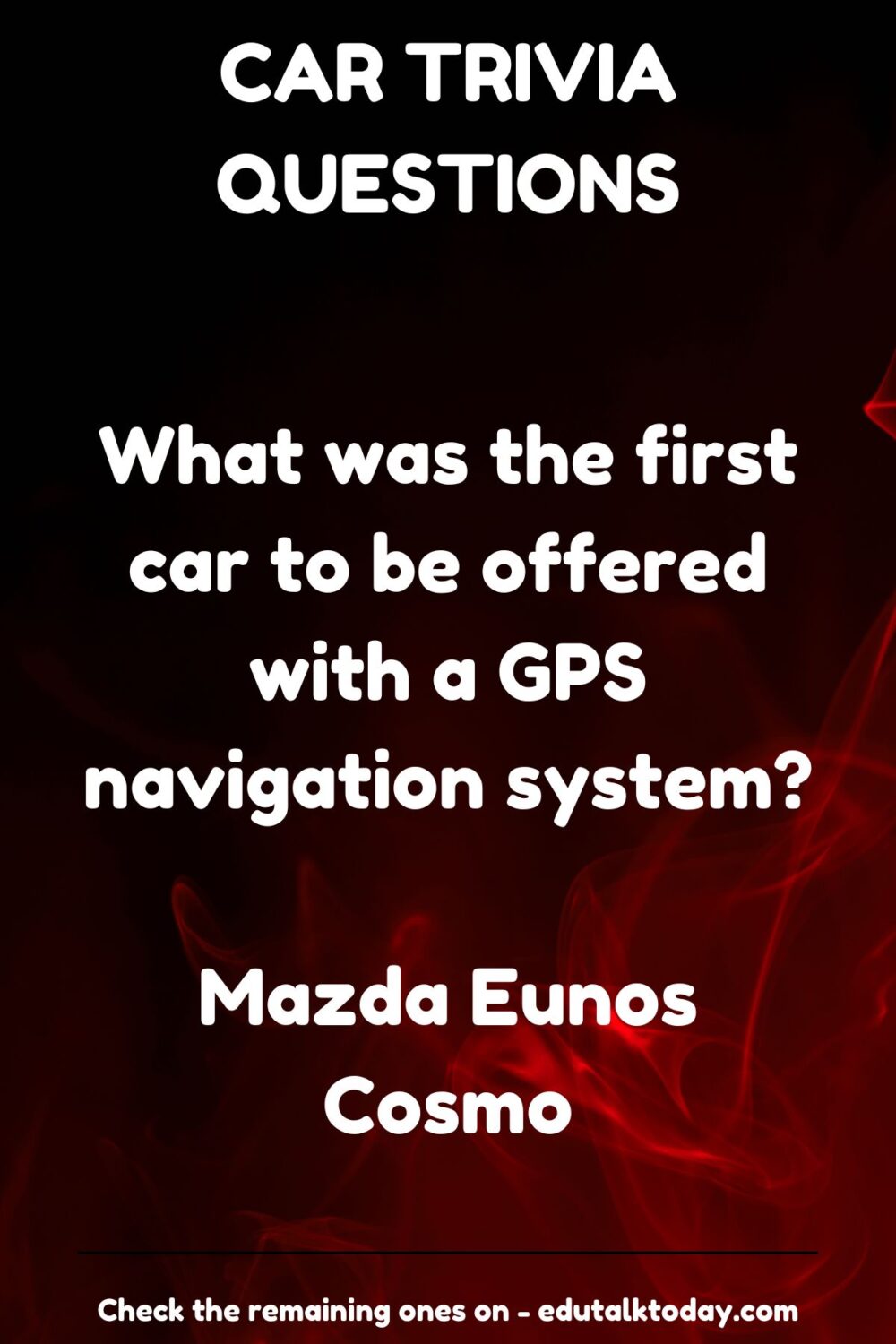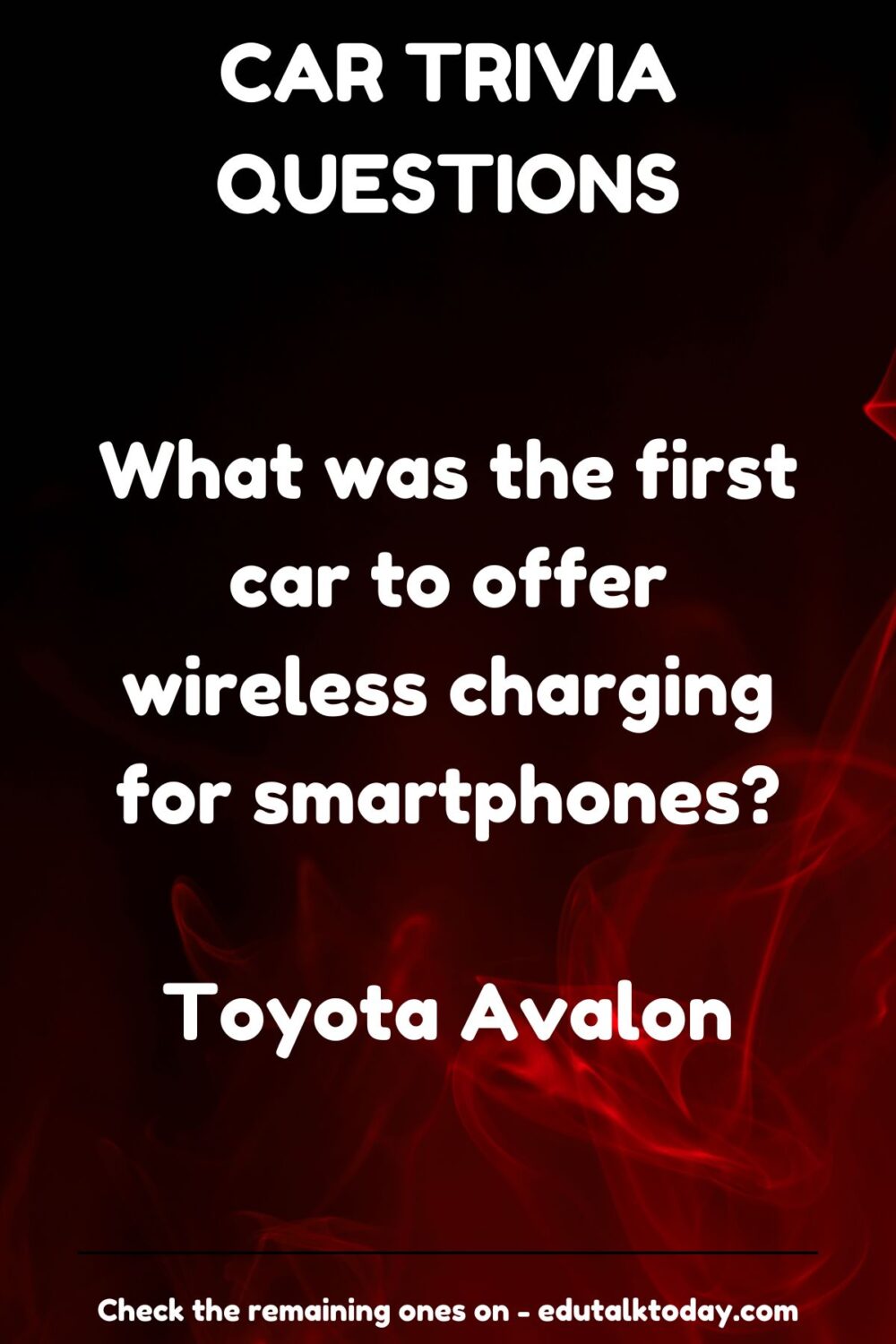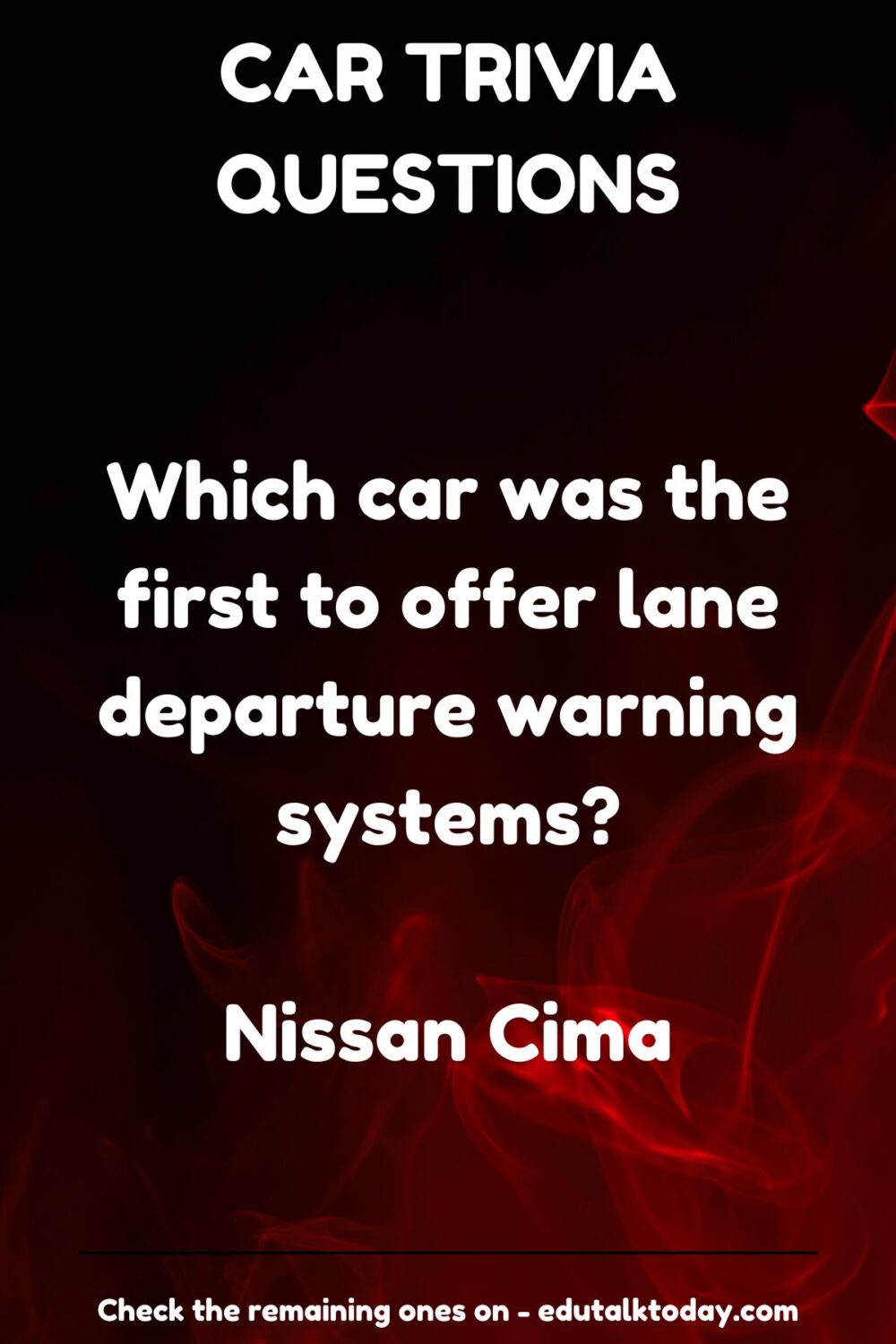75 Car Trivia Questions

If you consider yourself a car enthusiast or simply enjoy learning about automobiles, this trivia quiz is for you!
Whether you’re a gearhead who knows every make and model or just someone who enjoys a good challenge, these trivia questions will put your automotive knowledge to the test.
So buckle up and see how many you can answer correctly!
Car Trivia Questions
Q. Which car manufacturer was the first to produce more than 10 million vehicles in a single year?
A. Toyota
In 2013, Toyota became the first automaker to produce over 10 million vehicles in a single year. This milestone marked a significant achievement in automotive history, reflecting Toyota’s global reach and production capabilities. The company’s production strategy, including its focus on efficiency and quality, contributed to this success.
Q. What was the first mass-produced car to feature a fully automatic transmission?
A. Oldsmobile Hydra-Matic
The Oldsmobile Hydra-Matic, introduced in 1939 for the 1940 model year, was the first mass-produced car to offer a fully automatic transmission. This innovation revolutionized driving by eliminating the need for manual gear changes, making cars more accessible to a broader range of drivers.
Q. Which car holds the record for the longest production run of any single model in automotive history?
A. Volkswagen Beetle
The Volkswagen Beetle holds the record for the longest production run, with continuous production from 1938 until 2003. The Beetle became an iconic symbol of the automotive industry, known for its distinctive shape, durability, and affordability.
Q. What was the first car to be manufactured using an assembly line, revolutionizing the automobile industry?
A. Ford Model T
The Ford Model T, introduced in 1908, was the first car to be mass-produced using an assembly line. This method, pioneered by Henry Ford, dramatically reduced the cost of production and made the Model T affordable to the average consumer, fundamentally changing the automobile industry.
Q. Which car brand introduced the first production turbocharged car?
A. Chevrolet
The Chevrolet Corvair Monza, introduced in 1962, was the first production car to be offered with a turbocharged engine. This innovation provided significant power boosts, making the Corvair Monza a notable vehicle in automotive history.

Q. What car was the first to have a computer-controlled engine?
A. Cadillac Seville
The 1979 Cadillac Seville was the first car to feature a computer-controlled engine, which was part of an early fuel injection system. This innovation marked the beginning of electronic engine management, improving fuel efficiency and emissions control.
Q. Which was the first car to feature airbags as a standard safety feature?
A. Porsche 944 Turbo
The 1987 Porsche 944 Turbo was the first car to offer driver and passenger airbags as standard equipment. This marked a significant step forward in automotive safety, as airbags became a critical feature in protecting occupants during collisions.
Q. What is the fastest production car in the world as of 2024?
A. Bugatti Chiron Super Sport 300+
As of 2024, the Bugatti Chiron Super Sport 300+ holds the title of the fastest production car, reaching a top speed of 304.77 mph. This incredible speed was achieved through advanced engineering, aerodynamics, and a powerful 8.0-liter W16 engine.
Q. Which company introduced the first hybrid electric vehicle to the mass market?
A. Toyota
Toyota introduced the first mass-market hybrid electric vehicle, the Prius, in 1997. The Prius combined a traditional internal combustion engine with an electric motor, leading to significant fuel efficiency gains and setting the stage for the widespread adoption of hybrid technology.
Q. What was the first car to exceed 1 million units sold in a single year?
A. Chevrolet Impala
The Chevrolet Impala became the first car to exceed 1 million units sold in a single year, achieving this milestone in 1965. The Impala’s success was due to its combination of style, performance, and affordability, making it a popular choice among American consumers.

Q. Which car model was the first to be equipped with anti-lock brakes (ABS)?
A. Mercedes-Benz S-Class
The Mercedes-Benz S-Class (W116) introduced the first production anti-lock braking system (ABS) in 1978. Developed in collaboration with Bosch, ABS prevented wheel lock-up during braking, significantly improving safety by allowing drivers to maintain steering control.
Q. Which car company was the first to install seat belts as standard equipment in all its cars?
A. Volvo
Volvo was the first automaker to install seat belts as standard equipment in all its cars, starting in 1959 with the Volvo PV544. Volvo’s commitment to safety led to the widespread adoption of seat belts, which have since become a mandatory safety feature in vehicles worldwide.
Q. What was the first American car to be equipped with a rear-view camera?
A. Buick Centurion
The 1956 Buick Centurion concept car was the first to feature a rear-view camera, although it was not a production vehicle. This innovation provided a view of the area behind the car, laying the groundwork for the rear-view cameras that are now standard in modern vehicles.
Q. Which automaker developed the first mass-produced electric car in modern history?
A. General Motors
General Motors developed the first mass-produced electric car in modern history, the EV1, in the mid-1990s. Although it was only available through lease and had a limited production run, the EV1 was a groundbreaking vehicle that influenced the development of later electric cars.
Q. What car was the first to feature cruise control?
A. Chrysler Imperial
The 1958 Chrysler Imperial was the first car to offer cruise control, a feature that automatically maintained a set speed without the driver needing to keep their foot on the accelerator. This innovation enhanced driving comfort and fuel efficiency, especially on long highway journeys.

Q. Which was the first car to feature a catalytic converter to reduce emissions?
A. 1975 Chevrolet models
In response to stricter emissions regulations in the United States, General Motors introduced catalytic converters on their 1975 Chevrolet models. The catalytic converter was a revolutionary device that significantly reduced harmful emissions, helping to meet the new standards set by the Clean Air Act.
Q. What was the first car to be fitted with a turbocharged diesel engine?
A. Mercedes-Benz 300SD
The Mercedes-Benz 300SD, introduced in 1978, was the first production car to feature a turbocharged diesel engine. This engine provided better performance and efficiency compared to naturally aspirated diesel engines, marking a significant advancement in automotive technology.
Q. Which car company introduced the first retractable hardtop roof?
A. Ford
The 1957 Ford Fairlane 500 Skyliner was the first car to feature a retractable hardtop roof. This innovative design allowed drivers to enjoy the benefits of both a convertible and a hardtop, with the roof retracting into the trunk at the push of a button.
Q. What was the first production car to be offered with a GPS navigation system?
A. Mazda Eunos Cosmo
The 1990 Mazda Eunos Cosmo was the first production car to offer a GPS navigation system. This early system provided drivers with turn-by-turn directions and marked the beginning of a new era in automotive convenience and technology.
Q. Which was the first car to be built with an aluminum body?
A. Audi A8
The 1994 Audi A8 was the first mass-produced car to feature an aluminum body, which Audi called the “Audi Space Frame.” The use of aluminum significantly reduced the car’s weight, improving fuel efficiency and performance while maintaining structural rigidity.

Q. What was the first American car to offer a V8 engine?
A. Cadillac
The 1915 Cadillac Type V-8 was the first American production car to be equipped with a V8 engine. This engine configuration provided more power and smoother operation, quickly becoming popular in the luxury car segment and eventually spreading to other types of vehicles.
Q. Which car was the first to have four-wheel disc brakes?
A. Jaguar C-Type
The Jaguar C-Type, which competed in the 1953 Le Mans 24 Hours race, was the first car to feature four-wheel disc brakes. This braking system provided better stopping power and durability compared to drum brakes, and it played a crucial role in the C-Type’s success in racing.
Q. Which automaker was the first to introduce the “check engine” light as a diagnostic tool?
A. General Motors
General Motors introduced the “check engine” light in the 1980s as part of their onboard diagnostic system (OBD). This light alerts drivers to potential issues with the engine or emissions system, prompting them to seek service to prevent more severe problems.
Q. Which was the first car to offer adaptive cruise control?
A. Mitsubishi Diamante
The 1992 Mitsubishi Diamante was the first production car to offer adaptive cruise control, a system that automatically adjusts the car’s speed to maintain a safe distance from the vehicle ahead. This feature has since become a standard safety and convenience feature in many modern cars.
Q. What car was the first to be offered with a heads-up display (HUD)?
A. Oldsmobile Cutlass Supreme
The 1988 Oldsmobile Cutlass Supreme was the first production car to offer a heads-up display (HUD), projecting important information, such as speed, onto the windshield in the driver’s line of sight. This technology improved driver safety by allowing them to keep their eyes on the road.

Q. Which car model was the first to include a factory-installed cassette player?
A. Ford Mustang
The 1966 Ford Mustang was one of the first cars to offer a factory-installed cassette player, marking a significant upgrade in in-car entertainment. This feature allowed drivers and passengers to listen to their own music collections, a major convenience at the time.
Q. What was the first car to offer seat heaters as an option?
A. Saab 99
The Saab 99, introduced in 1971, was the first car to offer seat heaters as an option. This feature, initially popular in colder climates, has since become a standard or optional feature in many vehicles, providing added comfort during winter driving.
Q. Which car was the first to feature a rear spoiler?
A. Plymouth Superbird
The 1970 Plymouth Superbird was one of the first production cars to feature a rear spoiler, designed to improve aerodynamics and provide downforce at high speeds. The Superbird’s large, distinctive rear wing became an iconic feature of American muscle cars.
Q. What was the first car to feature keyless entry?
A. Mercedes-Benz S-Class
The 1998 Mercedes-Benz S-Class was the first car to offer a keyless entry system, allowing drivers to unlock and start their vehicles without removing the key from their pocket or bag. This feature added a new level of convenience and security to the driving experience.
Q. Which was the first car to offer electronic stability control (ESC)?
A. Mercedes-Benz S600
The 1995 Mercedes-Benz S600 was the first production car to feature electronic stability control (ESC), a system that helps prevent skidding by automatically applying brakes to individual wheels. ESC has since become a mandatory safety feature in many countries.

Q. What was the first production car to exceed 200 mph?
A. Ferrari F40
The Ferrari F40, introduced in 1987, was the first production car to exceed 200 mph. With its lightweight construction and powerful twin-turbocharged V8 engine, the F40 set a new benchmark for performance and remains an iconic supercar.
Q. Which car brand was the first to offer a hybrid electric vehicle in the U.S. market?
A. Honda
Honda introduced the Insight in 1999, the first hybrid electric vehicle available in the U.S. market. The Insight’s advanced technology and impressive fuel economy made it a significant milestone in the development of environmentally friendly vehicles.
Q. What was the first car to feature automatic climate control?
A. Chrysler Imperial
The 1953 Chrysler Imperial was the first car to offer automatic climate control, a system that maintained a preset temperature inside the vehicle by automatically adjusting the heating and cooling systems. This feature provided enhanced comfort for passengers and became a standard feature in luxury cars.
Q. Which car was the first to offer lane departure warning systems?
A. Nissan Cima
The 2001 Nissan Cima was the first production car to offer a lane departure warning system, which alerts drivers when they unintentionally drift out of their lane. This technology has since become a common safety feature in many vehicles, helping to prevent accidents caused by driver distraction.
Q. What was the first car to be designed using computer-aided design (CAD)?
A. Ford Mustang
The 1980 Ford Mustang was one of the first cars to be designed using computer-aided design (CAD) technology. CAD allowed designers and engineers to create more precise and complex designs, improving the overall quality and efficiency of the car development process.

Q. Which car was the first to feature a rotary (Wankel) engine?
A. NSU Ro 80
The NSU Ro 80, introduced in 1967, was the first production car to feature a rotary (Wankel) engine. This engine design, known for its smooth operation and compact size, was a significant departure from traditional piston engines, though it faced challenges with reliability.
Q. What was the first production car to feature an active suspension system?
A. Citroën SM
The 1970 Citroën SM was the first production car to feature an active suspension system, which automatically adjusted the car’s ride height and damping to provide a smooth ride. This technology was a hallmark of Citroën’s innovative approach to vehicle design.
Q. Which car brand was the first to produce a million vehicles in a single year?
A. Ford
Ford became the first automaker to produce a million vehicles in a single year in 1922. This achievement was made possible by the success of the Model T and Ford’s innovative assembly line production methods, which revolutionized the automotive industry.
Q. Which was the first production car to feature dual overhead camshafts (DOHC)?
A. Fiat 124 Sport Spider
The Fiat 124 Sport Spider, introduced in 1966, was one of the first mass-produced cars to feature dual overhead camshafts (DOHC). This engine design improved performance by allowing more precise control of valve timing, which became a common feature in high-performance vehicles.
Q. What was the first car to offer a rear-seat entertainment system?
A. Lincoln Navigator
The 2000 Lincoln Navigator was the first production vehicle to offer a rear-seat entertainment system, featuring a flip-down screen and a DVD player. This feature provided passengers, especially children, with entertainment during long drives, setting a trend for luxury SUVs.

Q. Which car was the first to have a hybrid electric drivetrain?
A. Toyota Prius
The Toyota Prius, introduced in 1997, was the first mass-produced car with a hybrid electric drivetrain. The Prius combined a gasoline engine with an electric motor to improve fuel efficiency and reduce emissions, paving the way for the widespread adoption of hybrid vehicles.
Q. What was the first car to be produced entirely by robots?
A. Fiat Ritmo
The Fiat Ritmo, introduced in 1978, was one of the first cars to be produced largely by robots at Fiat’s new “Robogate” assembly line. This automated production process reduced costs and improved quality, marking a significant step forward in manufacturing technology.
Q. Which was the first car to offer an all-wheel-drive system?
A. Jensen FF
The Jensen FF, introduced in 1966, was the first production car to feature an all-wheel-drive (AWD) system. This system provided better traction and stability, especially in adverse weather conditions, and was a precursor to the AWD systems commonly found in modern vehicles.
Q. Which car was the first to offer a 10-speed automatic transmission?
A. Ford F-150
The 2017 Ford F-150 was the first production vehicle to offer a 10-speed automatic transmission, developed in collaboration with General Motors. This transmission provided smoother shifts, improved fuel efficiency, and enhanced performance by allowing the engine to operate at optimal RPMs more often.
Q. What was the first car to feature an aluminum V8 engine?
A. Buick Special
The 1961 Buick Special was the first production car to feature an aluminum V8 engine. This engine was lighter and more efficient than traditional cast-iron engines, providing better performance and fuel economy. The aluminum V8 design influenced engine development for decades.

Q. Which car was the first to offer a digital dashboard?
A. Aston Martin Lagonda
The 1976 Aston Martin Lagonda was the first production car to feature a digital dashboard, using LED displays for instruments like speed and fuel level. This futuristic design was ahead of its time and marked the beginning of the shift from analog to digital displays in vehicles.
Q. What was the first car to be equipped with daytime running lights (DRLs)?
A. Volvo 240
The 1984 Volvo 240 was one of the first production cars to feature daytime running lights (DRLs), designed to increase the car’s visibility to other drivers during daylight hours. DRLs have since become a standard safety feature in many countries.
Q. Which car was the first to have a carbon-fiber body?
A. McLaren F1
The McLaren F1, introduced in 1992, was the first production car to feature a carbon-fiber monocoque chassis and body. This material significantly reduced the car’s weight while maintaining strength and rigidity, contributing to the F1’s reputation as one of the greatest supercars of all time.
Q. What was the first car to offer a rearview camera as a standard feature?
A. Honda Odyssey
The 2005 Honda Odyssey was one of the first vehicles to offer a rearview camera as a standard feature. This safety feature helped drivers see obstacles behind their vehicles when reversing, reducing the risk of accidents and making parking easier.
Q. Which was the first production car to offer a dual-clutch transmission (DCT)?
A. Volkswagen Golf R32
The 2003 Volkswagen Golf R32 was the first production car to feature a dual-clutch transmission (DCT), offering faster and smoother gear shifts compared to traditional manual or automatic transmissions. DCTs have since become popular in high-performance and luxury vehicles.

Q. What was the first car to feature a turbocharged gasoline engine?
A. Chevrolet Corvair Monza
The 1962 Chevrolet Corvair Monza was the first production car to feature a turbocharged gasoline engine. This innovation provided a significant increase in power, making the Corvair Monza one of the most advanced and performance-oriented cars of its time.
Q. Which was the first car to feature a hybrid powertrain in a supercar?
A. Porsche 918 Spyder
The Porsche 918 Spyder, introduced in 2013, was the first supercar to feature a hybrid powertrain. Combining a high-performance gasoline engine with electric motors, the 918 Spyder delivered both incredible speed and improved efficiency, setting a new standard for hybrid technology in performance cars.
Q. What was the first car to offer a heated steering wheel?
A. BMW 7 Series
The 1997 BMW 7 Series was one of the first production cars to offer a heated steering wheel, providing drivers with added comfort during cold weather. This feature has since become a common option in luxury vehicles.
Q. Which was the first car to be offered with a self-parking system?
A. Lexus LS 460
The 2006 Lexus LS 460 was the first production car to feature a self-parking system, which used sensors and cameras to automatically steer the car into a parking space. This technology has since been refined and is now available on many vehicles, making parking easier and reducing the risk of accidents.
Q. What was the first car to feature Apple CarPlay?
A. Ferrari FF
The 2014 Ferrari FF was the first production car to offer Apple CarPlay, a system that allows drivers to integrate their iPhones with the car’s infotainment system. This feature provided seamless access to apps, navigation, and music, enhancing the driving experience.

Q. Which was the first car to offer a heads-up display (HUD) with augmented reality (AR)?
A. Mercedes-Benz S-Class
The 2021 Mercedes-Benz S-Class was the first production car to feature a heads-up display (HUD) with augmented reality (AR), projecting navigation directions and other information onto the windshield in a way that aligned with the road ahead. This technology represented a significant advancement in driver assistance and safety.
Q. What was the first car to feature an integrated hands-free phone system?
A. Chrysler 300M
The 1999 Chrysler 300M was one of the first cars to offer an integrated hands-free phone system, allowing drivers to make and receive calls without taking their hands off the wheel. This feature improved safety by reducing driver distraction.
Q. Which was the first car to offer a surround-view camera system?
A. Infiniti EX35
The 2008 Infiniti EX35 was the first production car to offer a surround-view camera system, providing a 360-degree view around the vehicle to assist with parking and maneuvering in tight spaces. This technology has since become a popular safety feature in many vehicles.
Q. What was the first car to offer an active noise cancellation system?
A. Honda Legend
The 1992 Honda Legend was one of the first production cars to feature an active noise cancellation system, which used microphones and speakers to reduce unwanted cabin noise. This innovation improved cabin comfort by creating a quieter driving environment.
Q. Which car was the first to feature electric power steering?
A. Fiat Panda
The 1999 Fiat Panda was the first production car to feature electric power steering, a system that replaced traditional hydraulic power steering with an electric motor. This technology provided variable steering assistance, improved fuel efficiency, and reduced maintenance needs.

Q. What was the first car to offer a plug-in hybrid powertrain?
A. Toyota Prius Plug-in Hybrid
The 2012 Toyota Prius Plug-in Hybrid was the first production car to offer a plug-in hybrid powertrain, allowing drivers to charge the car’s battery from an external power source and drive short distances on electric power alone. This innovation represented a significant step forward in reducing fuel consumption and emissions.
Q. Which was the first car to feature a fully digital instrument cluster?
A. Audi TT
The 2015 Audi TT was the first production car to feature a fully digital instrument cluster, known as the “Virtual Cockpit.” This system replaced traditional analog gauges with a customizable digital display, allowing drivers to view information such as navigation, media, and vehicle settings in a more modern and intuitive way.
Q. What was the first car to offer remote start as a factory option?
A. Cadillac Seville
The 1989 Cadillac Seville was one of the first production cars to offer remote start as a factory option. This feature allowed drivers to start the car’s engine from a distance, providing the convenience of pre-warming or cooling the car before getting in.
Q. Which car was the first to feature a panoramic sunroof?
A. Mercedes-Benz CL-Class
The 2000 Mercedes-Benz CL-Class was one of the first production cars to offer a panoramic sunroof, a large glass roof that extended over both the front and rear seats, providing an open, airy feel to the cabin and enhancing the driving experience.
Q. What was the first car to offer a hands-free liftgate?
A. Ford Escape
The 2013 Ford Escape was one of the first production vehicles to offer a hands-free liftgate, allowing drivers to open the rear hatch by simply waving their foot under the bumper. This feature added convenience, especially when carrying items or groceries.

Q. Which was the first car to feature an automatic emergency braking system (AEB)?
A. Volvo XC60
The 2008 Volvo XC60 was the first production car to offer an automatic emergency braking system (AEB), which could detect an impending collision and automatically apply the brakes to prevent or mitigate the impact. This technology has since become a critical safety feature in many vehicles.
Q. What was the first car to feature carbon-ceramic brakes?
A. Porsche 911 GT2
The 2001 Porsche 911 GT2 was one of the first production cars to feature carbon-ceramic brakes, which provided superior braking performance, especially at high speeds, and were more resistant to fading and wear compared to traditional steel brakes.
Q. Which car was the first to offer a hybrid powertrain in an SUV?
A. Ford Escape Hybrid
The 2005 Ford Escape Hybrid was the first production SUV to offer a hybrid powertrain, combining a gasoline engine with an electric motor to improve fuel efficiency and reduce emissions. This innovation marked a significant development in the hybrid vehicle market, expanding the technology to larger vehicles.
Q. What was the first car to offer a built-in vacuum cleaner?
A. Honda Odyssey
The 2014 Honda Odyssey was the first production vehicle to offer a built-in vacuum cleaner, known as the HondaVAC. This feature was designed to make it easier for families to clean up messes inside the car, especially on road trips.
Q. Which was the first car to offer wireless charging for smartphones?
A. Toyota Avalon
The 2013 Toyota Avalon was one of the first production vehicles to offer wireless charging for smartphones, using a Qi-compatible pad in the center console. This feature provided drivers with a convenient way to keep their devices charged without the need for cables.

Q. What was the first car to offer massaging seats?
A. Mercedes-Benz S-Class
The 2000 Mercedes-Benz S-Class was one of the first production cars to offer massaging seats, providing added comfort for drivers and passengers on long journeys. This feature became a hallmark of luxury vehicles and is now available in many high-end models.
Q. Which was the first car to feature a dual-mode exhaust system?
A. Chevrolet Corvette
The 2008 Chevrolet Corvette was one of the first production cars to offer a dual-mode exhaust system, which allowed drivers to switch between a quieter exhaust note for regular driving and a louder, more aggressive sound for performance driving. This feature enhanced the driving experience by offering a choice between comfort and sportiness.
Q. What was the first car to offer automatic parking as a standard feature?
A. BMW 7 Series
The 2003 BMW 7 Series was one of the first production cars to offer automatic parking as a standard feature, using sensors and cameras to steer the car into a parking space without driver input. This technology made parking easier and safer, especially in tight spaces.
Q. Which was the first car to feature variable valve timing (VVT)?
A. Alfa Romeo Spider
The 1980 Alfa Romeo Spider was one of the first production cars to feature variable valve timing (VVT), a technology that optimizes engine performance and efficiency by adjusting the timing of the engine’s valves based on driving conditions. VVT has since become a common feature in many modern engines.
Q. What was the first car to offer LED headlights as standard?
A. Audi R8
The 2008 Audi R8 was one of the first production cars to offer LED headlights as standard equipment. LED headlights provided better visibility, longer lifespan, and lower energy consumption compared to traditional halogen or xenon lights, setting a new standard in automotive lighting technology.






